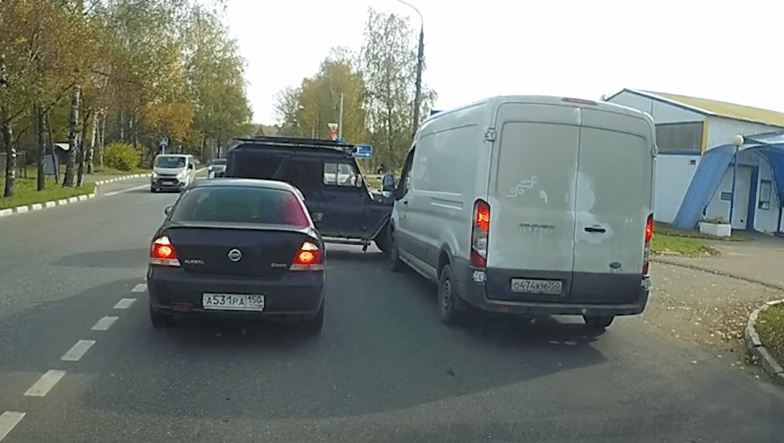
Cut-Through (Vehicles)
⮟ 📹 Opposite Side ⮟ 📹 Same Side
☠️ Alert:
? Questions:


📹 Opposite Side
📹 Same Side
☠️ Dangers of cutting through traffic
Increased risk of accidents: When a vehicle cuts through traffic, it is likely to cross several lanes of traffic and may not have enough time to slow down or react to other vehicles on the road. This can lead to accidents, especially if the driver misjudges the distance or speed of other vehicles. Violating traffic laws: Cutting through traffic is illegal in many areas and can result in fines or tickets. This can also lead to increased insurance rates and points on your driver's license. Angering other drivers: Cutting through traffic can be frustrating for other drivers who may have to slow down or change lanes to avoid a collision. This can lead to road rage and aggressive driving behaviors. Putting pedestrians at risk: Cutting through traffic can also be dangerous for pedestrians who may be crossing the road. Drivers who are cutting through traffic may not be paying attention to pedestrians and may not see them until it's too late. Reduced visibility: When cutting through traffic, drivers may not have a clear view of other vehicles or obstacles on the road. This can increase the risk of accidents or collisions.
? When is it safe to cut across traffic?
Ensure you have a clear, unobstructed view of the road in both directions. Avoid cutting across traffic in areas with limited visibility, such as curves, hills, or obstructions.
Obey all traffic lights, stop signs, and road markings. Only proceed when the traffic signal or sign permits your movement.
Wait for a sufficiently large gap in traffic from both directions. Ensure the gap is large enough to complete your maneuver without causing oncoming traffic to slow down or stop abruptly.
Signal your intention to turn well in advance to inform other drivers of your planned movement.
Before moving, check your mirrors and blind spots to ensure no vehicles, bicycles, or pedestrians are in your path.
When you see a safe gap, move smoothly and decisively. Hesitation can confuse other drivers and increase the risk of an accident.
Take into account the speed of oncoming vehicles. Faster-moving traffic requires larger gaps. Ensure you have enough distance to complete your maneuver without causing oncoming vehicles to slow down or stop abruptly.
Always check for pedestrians and cyclists before cutting across, especially in urban areas or near crosswalks.
Exercise extra caution in adverse weather conditions like rain, snow, or fog due to reduced visibility and longer stopping distances.
If turning at an intersection, follow the rules of the intersection, such as yielding to oncoming traffic when making a left turn.
Be aware of and follow any specific local traffic regulations regarding turning or crossing traffic at a right angle, as they can vary by region.
Make eye contact with other drivers if possible to ensure they are aware of your intention to cut across traffic.
? What should I do if the road is congested and I need to cut across traffic?
Look for Alternate Routes: If possible, plan an alternative route that avoids the need to cut across heavy traffic. Anticipate Congestion: If you know the area is usually congested, plan to travel during less busy times.
Use Turn Signals: Signal your intention to turn or cross well in advance to inform other drivers of your planned movement. Communicate Clearly: Use hand signals if necessary to communicate your intentions, especially if visibility is poor.
Be Patient: Wait for a sufficient gap in the traffic before attempting to cut across. This may take some time in heavy congestion. Use Eye Contact: Make eye contact with other drivers if possible to ensure they see you and understand your intention to cross.
Avoid Sudden Movements: Move slowly and steadily into the gap. Avoid sudden or erratic movements that can surprise other drivers. Proceed with Caution: Even if another driver waves you through, proceed cautiously and double-check for other vehicles or pedestrians.
Use Controlled Intersections: If possible, use intersections with traffic lights or stop signs to make your turn or cross. Traffic controls can create natural gaps in the traffic flow. Wait for Green Light: If you are at a traffic light, wait for the green light to proceed. Make sure oncoming traffic is stopping before you cross.
Look Both Ways: Always check for pedestrians and cyclists before crossing, especially in urban areas or near crosswalks. Yield to Pedestrians: Yield the right-of-way to pedestrians who are crossing legally.
Adhere to Laws: Make sure you are following all local traffic laws and regulations regarding turning and crossing at intersections.
Utilize Turning Lanes: If available, use designated turning lanes to position yourself for a safer turn or crossing.
Ask for Help: If you are unsure or find it too difficult to cut across on your own, you might seek assistance from a traffic officer or a pedestrian who can help signal other drivers.
Avoid Peak Hours: If possible, avoid making such maneuvers during peak traffic hours when congestion is at its worst.